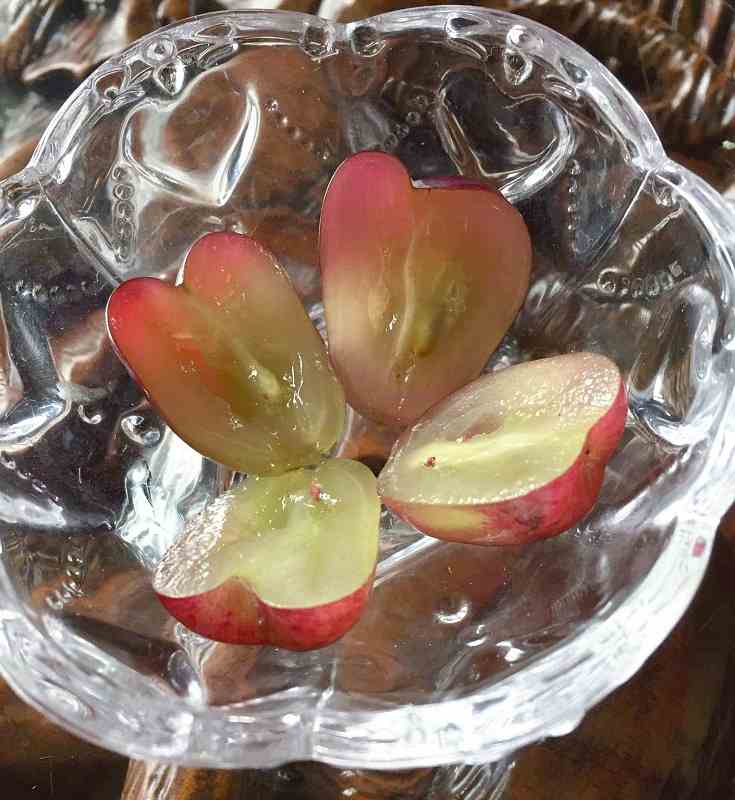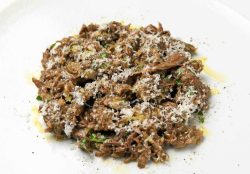
Tomio Shimura checks the growth of Fuji no Kagayaki grapes that his research institute developed in Fuefuki, Yamanashi Prefecture.
14:40 JST, August 12, 2021
New grape varieties with large berries and thin skins have become commonplace in fruit shops and supermarkets during their mainly summer to autumn growing season. Their rising popularity is on par with other mainstay fruit because they are easy to eat and viewed as healthy sweets.
Seedless, thin-skinned
As the mid-June harvest season approached, grapes with a deep purple hue hung from trellises in a greenhouse owned by Nikotto, an agricultural company based in Fuefuki, Yamanashi Prefecture. Called Fuji no Kagayaki, this seedless variety was developed by the Shimura Grape Research Institute in the city. This grape has dimpled berries and its skin can be easily eaten.
“Grapes have gone through significant change after the Shine Muscat variety hit the scene,” said Tomio Shimura, the head of the institute.
The hugely popular Shine Muscat is seedless with thin skin and was registered as a new variety in 2006 by the National Agriculture and Food Research Organization in Tsukuba, Ibaraki Prefecture.
Shimura crossbred Shine Muscat with other varieties to develop about 15 new ones with distinct characteristics, from the color to the shape.
One of these is the Yuho, with berries roughly the size of a chicken egg, while another variety is dubbed My Heart for its heart-shaped appearance when sliced vertically. While all of these new varieties have easily edible skins, some bunches sell for over ¥10,000.
“They’re easy to eat and there are many varieties, so I look forward to them every year,” said a corporate executive from Kawaguchi, Saitama Prefecture.
Domestically produced large grapes typically have black, green or red skin. For example, Kyoho is black with skin that is fairly thick and few people tend to eat it without peeling, while Shine Muscat is green.
In general, black grapes have a strong flavor, green grapes are refreshingly aromatic with less astringency and red grapes are less acidic.
The average sugar content of grapes is around 17 degree Brix, although there are very sweet grapes with a sugar content of more than 20 Brix. These sweeter varieties have grown exceptionally popular lately.
Shinku is one such sweeter grape that can be eaten as is, developed by the Shimane prefectural government. The selected ones with over 20 Brix are being shipped this month to Tokyo department stores and high-end supermarkets in Osaka.
Nagano Prefecture has trademarked the Queen Rouge variety, a red grape with 22-23 Brix that will be in season in late September. The prefecture also developed another variety dubbed Nagano Purple, which has dark edible skin, that it plans to sell together with Queen Rouge and Shine Muscat in a tricolor set.

Two vertically sliced My Heart grapes bear a heart-shaped appearance.
Increasingly popular
Japan’s annual expenditure on grapes per household of two or more members increased from ¥2,560 in 2015 to ¥3,107 in 2020, according to the National Survey of Family Income and Expenditure. Spending on apples over the same period declined while strawberries saw a slight increase.
According to Naoko Kubo, the manager in charge of public relations at the Shinjuku Takano fruit parlor in Tokyo, the rapid pace of selective breeding of strawberries and citrus fruits has led to diverse flavors, and grapes had long lost ground to these fruits. However, new grape varieties have been appearing in recent years.
“Grapes are increasingly popular as gifts and in fruit parlors,” Kubo said.
“More people are choosing to eat fruit when they want to eat something sweet,” Kubo added. “Grape skins are nutritious and have a pleasant fragrance, so eating the grapes whole is also appealing.”
Kazuya Sano, the chief manager of the product management department at fruit tart specialty shop Qu’il fait bon, said: “Grapes’ green or purple colors make confections look wonderful. Since ones with edible skins have become popular, we’re now able to make beautiful tarts fully covered in grapes.”
The ease of eating these new thin-skinned, seedless varieties has been a key to grapes’ growing popularity.
“It’s easy to just pop a grape in your mouth and nothing is wasted,” besides the stems, said Akifumi Azuma, a senior researcher at the National Agriculture and Food Research Organization’s Institute of Fruit Tree and Tea Science. “Grapes fit the times, so I think more new varieties will appear.”

Shinku red grapes are being shipped for the first time this month.
Imports rising
Grapes from overseas are also gaining popularity. Imports totaled 44,369 tons in 2020, more than three times the figure from 10 years ago. The United States is the largest exporter to Japan, followed by Chile and Australia.
Table grapes with thin skins and a firm texture are favored in Western countries, according to an official of the Tokyo-based Funasho Shoji Co., which imports fruit. These grapes are almost never peeled and seedless varieties are popular.
“Imported grapes are less expensive than domestic ones, and with a greater number of large retail stores carrying them, their reach is spreading,” the official said. “The popularity of domestic grapes looks to be pushing up sales of imported ones.”
"Features" POPULAR ARTICLE
-

Sanrio to Open Museum in Yamanashi Pref. Dedicated to Founder, Exhibits Include Hello Kitty, Other Characters
-

Legendary Sushi Chef Jiro Ono Turns 100: ‘I Have No Regrets’
-

Autumn Foliage Surrounds Visitors to Tokyo’s Showa Kinen Park
-

My Daughter No Longer Speaks to Me, But I Want to See Her and My Grandchild
-

Kumamoto: Public Bath Refurbished as Library Where You Can Chat, Take Photos
JN ACCESS RANKING
-

Keidanren Chairman Yoshinobu Tsutsui Visits Kashiwazaki-Kariwa Nuclear Power Plant; Inspects New Emergency Safety System
-

Imports of Rare Earths from China Facing Delays, May Be Caused by Deterioration of Japan-China Relations
-

University of Tokyo Professor Discusses Japanese Economic Security in Interview Ahead of Forum
-

Japan Pulls out of Vietnam Nuclear Project, Complicating Hanoi’s Power Plans
-

Govt Aims to Expand NISA Program Lineup, Abolish Age Restriction


























